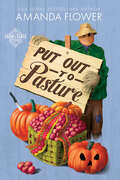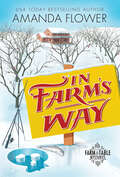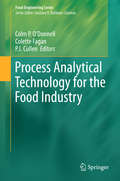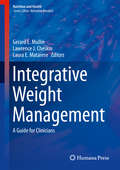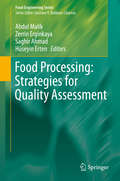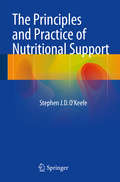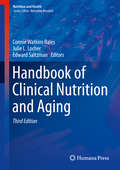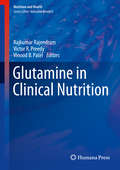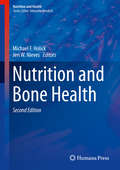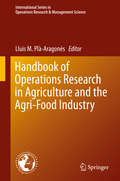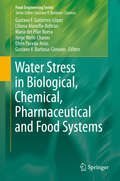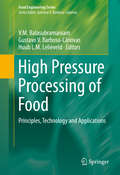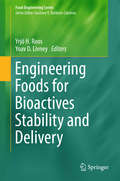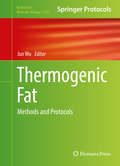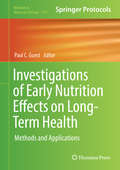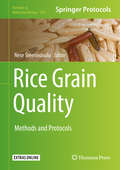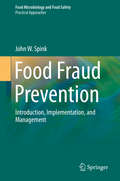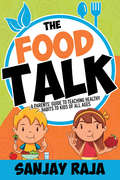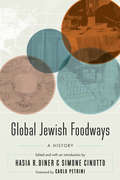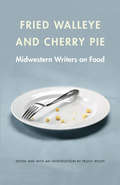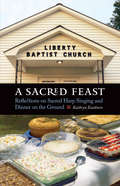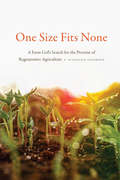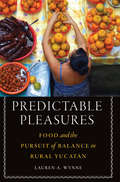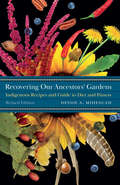- Table View
- List View
Put Out to Pasture (Farm to Table Mysteries #2)
by Amanda FlowerA delightful new cozy mystery from USA Today bestselling author Amanda Flower!There's fowl play afoot on the farmShiloh Bellamy has saved her family's farm from financial ruin—but now what? She's barely scraping by on the farm's new organic business model and the fall festival she organized to drum up business comes to a screeching halt when the body of a prominent townswoman is discovered underneath a scarecrow in a nearby field. Worst of all, the evidence points to Shiloh's childhood best friend, Kristy, as the prime suspect.Between cooking up delicious treats made with her farm's produce, convincing her cantankerous father to let her do things her own way, and dealing with a newcomer in town who could be serious competition for her customers, Shiloh doesn't have time to wade into a murder investigation. But with a killer on the loose and suspicious activity circling closer and closer to Shiloh and the people she loves, she realizes there's nothing to do but roll up her sleeves and get down to the dirty work of finding the killer and clearing Kristy's name once and for all.This book is perfect for cozy mystery readers and fans of Kate Carlisle, Denise Swanson, and Bree Baker!
In Farm's Way (Farm to Table Mysteries #3)
by Amanda Flower"An adorable pug and characters you can invest in enliven a very cherry-centric mystery." — Kirkus ReviewsWhen the biggest catch at the annual Ice Fishing Derby is the body of brewmaster Wallace, Shiloh must reel in the killer before her farm goes belly-up. Shiloh Bellamy still expects the last few Winter months to be busy with repairs, spring planning, and networking with local businesses. She might even be able to broker a new partnership with Fields Brewery and its organic brewer's association. Well, she could if the owner, Wallace, wasn't found murdered at the county Ice Fishing Derby.Once again, Shiloh gets tangled up in the investigation when the police ignore an entire crop of suspects to blame one of her friends. She'll have to dig deep to find the truth, reel in a killer, and convince her city-slicker pug to wear his winter boots. But with Bellamy Farm still struggling, can Shiloh spare the time to look into the town's fishy characters? Or will her dream farm be the next thing floating belly up?USA Today bestselling Amanda Flower returns to the Farm to Table cozy mystery series with another exciting sleuthing adventure!Readers love the Farm to Table Mysteries:"Amanda Flower is a master at writing mysteries and keeping the reader interested the whole time.""I enjoyed all the characters in this new series... Animal lovers will love Huckleberry and Esmerelda.""As usual, her cute mysteries leave me wanting more."
Process Analytical Technology for the Food Industry
by P. J. Cullen Colm P. O'Donnell Colette FaganThe Process Analytical Technology (PAT) initiative aims to move from a paradigm of 'testing quality in' to 'building quality in by design'. It can be defined as the optimal application of process analytical technologies, feedback process control strategies, information management tools, and/or product-process optimization strategies. Recently, there have been significant advances in process sensors and in model-based monitoring and control methodologies, leading to enormous opportunities for improved performance of food manufacturing processes and for the quality of food products with the adoption of PAT. Improvements in process efficiency, reduced product variability, enhanced traceability, process understanding, and decreased risk of contamination are some of the benefits arising from the introduction of a PAT strategy in the food industry. Process Analytical Technology for the Food Industry reviews established and emerging PAT tools with potential application within the food processing industry. The book will also serve as a reference for industry, researchers, educators, and students by providing a comprehensive insight into the objectives, challenges, and benefits of adopting a Process Analytical Technology strategy in the food industry.
Integrative Weight Management
by Gerard E. Mullin Lawrence J. Cheskin Laura E. MatareseIntegrative Weight Management: A Guide for Clinicians intends to educate physicians and nutritionists about the wide ranges of approaches to weight control from non-traditional sources. The options for weight management in conventional practices are limited to a small number of medications, a confusing array of dietary approaches and surgical procedures with their inherent risks and complications Unfortunately medical practitioners are not exposed to nutrition and weight control principles during training and thus are reluctant to manage their patients weight control issues This volume is structured into 4 sections: Introduction to Weight Management Disorders; Morbidity and Mortality of Obesity; Therapy of Obesity; and Integrative Medicine and Obesity Integrative Weight Management: A Guide for Clinicians represents a powerful collaboration of dozens of leading experts in the fields of nutrition, weight management and integrative medicine who have managed countless numbers of patients and summarized the research from thousands of articles to create an up-to- date state of the art guide for healthcare practitioners, allied health professionals and public health authorities who manage those who are overweight/obese along with the associated metabolic consequences.
Food Processing: Strategies for Quality Assessment
by Abdul Malik Zerrin Erginkaya Saghir Ahmad Hüseyin ErtenThe aim of the food processing is to ensure microbiological and chemical safety of foods, adequate nutrient content and bioavailability and acceptability to the consumer with regard to sensory properties and ease of preparation. Processing may have either beneficial or harmful effects on these properties, so each of these factors must be taken into account in the design and preparation of foods. This book offers a unique dealing with the subject and provides not only an update of state-of-the art techniques in many critical areas of food processing and quality assessment, but also the development of value added products from food waste, safety and nanotechnology in the food and agriculture industry and looks into the future by defining current obstacles and future research goals. This book is not intended to serve as an encyclopedic review of the subject. However, the various chapters incorporate both theoretical and practical aspects and may serve as baseline information for future research through which significant development is possible.
The Principles and Practice of Nutritional Support
by Stephen J. D. O'KeefeThis book provides the reader with an understanding of human nutritional and metabolic physiology and how it goes wrong in illness. Divided into three major sections, the volume instructs the reader on how and when to use nutritional support, and includes a summary of the published outcome studies on the application of nutritional support to the management of common illnesses. In this way, the book supplies the reader with all the known information on how to make the best judgment of when, what and how to feed sick patients. Authored by a renowned expert in the field, The Principles and Practice of Nutritional Support is a valuable resource for gastroenterologists, surgeons, critical care physicians, endocrinologists, and all those involved with patient-care, both in hospital, in rehabilitation, or at home.
Handbook of Clinical Nutrition and Aging
by Connie Watkins Bales Julie L. Locher Edward SaltzmanThis is the new and fully revised third edition of the well-received text that is the benchmark book in the field of nutrition and aging. The editors (specialists in geriatric nutrition, medical sociology, and clinical nutrition, respectively) and contributors (a panel of recognized academic nutritionists, geriatricians, clinicians, and other scientists) have added a number of new chapters and have thoroughly updated the widely acclaimed second edition. This third edition provides fresh perspectives and the latest scientific and clinical developments on the interaction of nutrition with age-associated disease and provides practical, evidence-based options to enhance this at-risk population's potential for optimal health and disease prevention. Chapters on a wide range of topics, such as the role of nutrition in physical and cognitive function, and coverage of an array of clinical conditions (obesity, diabetes, heart failure, cancer, kidney disease, osteoporosis), compliment chapters on food insecurity, anti-aging and nutritional supplements, making this third edition uniquely different from previous editions. Handbook of Clinical Nutrition and Aging, Third Edition, is a practical and comprehensive resource and an invaluable guide to nutritionists, physicians, nurses, social workers and others who provide health care for the ever-increasing aging population.
Glutamine in Clinical Nutrition
by Victor R. Preedy Vinood B. Patel Rajkumar RajendramGlutamine is the most abundant amino acid and is a major contributor to whole body nitrogen metabolism and is considered to be "conditionally essential. " Glutamine in Health and Disease presents the application of current nutritional knowledge by physicians and dietitians and incorporates emerging fields of science and important discoveries. Section 1 covers glutamine structure and function, glutamine synthetase, glutamine binding protein, glutamine transport, glutamine-rich activation domains and transcription, glutamine transaminase and cell biochemistry. Section 2 covers glucose-independent glutamine metabolism, intestinal barrier function, thyroid-stimulating hormone, glutamine resonances, focal ischemia, plasma glutamine, metabolic stress, cancer and absorption. Section 3 covers dipeptide-bound glutamine, DNA protection, oxidative stress, NF-KB, the inflammatory response, the lung, kidney, GI tract and liver, autophagy, ethanol and diabetes. Finally, Section 4 covers the use of glutamine in preoperative states, enteral and parenteral nutrition, pulmonary infections, cancer, hypoxic injury, arginyl-glutamine, paediatrics, pancreatic surgery, the elderly, gastric emptying gastric bypass and use glutamine cocktails. Written by authors of international and national standing, leaders in the field and trendsetters, Glutamine in Health and Disease is essential reading for nutritionists and dietitians, public health scientists, physicians, epidemiologists, policy makers, and health care professionals of various disciplines.
Nutrition and Bone Health
by Michael F. Holick Jeri W. NievesThis newly revised edition contains updated versions of all of the topics that were in the first edition and has been substantially expanded with an additional 5 chapters. Each chapter includes information from the most up-to-date research on how nutritional factors can affect bone health, written with an evidence-based focus and complete with comprehensive references for each subject. Nutrition and Bone Health, second edition covers all aspects of nutrition and the skeleton, from the history and fundamentals, to the effects of macronutrients, minerals, vitamins, and supplements, and even covers the effects of lifestyle, the different life stages, and nutrition-related disorders and secondary osteoporosis. New chapters include HIV & AIDs and the skeleton, celiac disease and bone health, and nutrition and bone health in space. Nutrition and Bone Health, second edition is a necessary resource for health care professionals, medical students, graduate students, dietitians, and nutritionists who are interested in how nutrition affects bone health during all stages of life.
Handbook of Operations Research in Agriculture and the Agri-Food Industry
by Lluis M. Plà-AragonésThe scope of this book is Operations Research methods in Agriculture and a thorough discussion of derived applications in the Agri-food industry. The book summarizes current research and practice in this area and illustrates the development of useful approaches to deal with actual problems arising in the agriculture sector and the agri-food industry. This book is intended to collect in one volume high quality chapters on Methods and Applications in Agriculture and Agri-food industry considering both theoretical issues and application results. Methods applied to problems in agriculture and the agri-food industry include, but are not restricted to, the following themes: Dynamic programming Multi-criteria decision methods Markov decision processes Linear programming Stochastic programming Parameter estimation and knowledge acquisition Learning from data Simulation Descriptive and normative decision tree techniques, including: agent modelling and simulation, and state of the art surveys Each chapter includes some standard and traditional methodology but also some recent research advances. All the applications presented in the chapters have been inspired and motivated by the demands from the agriculture and food production areas.
Food Safety = Behavior
by Frank YiannasThis book helps in Achieving food safety success which requires going beyond traditional training, testing, and inspectional approaches to managing risks. It requires a better understanding of the human dimensions of food safety. In the field of food safety today, much is documented about specific microbes, time/temperature processes, post-process contamination, and HACCP-things often called the hard sciences. There is not much published or discussed related to human behavior-often referred to as the "soft stuff. " However, looking at foodborne disease trends over the past few decades and published regulatory out-of-compliance rates of food safety risk factors, it's clear that the soft stuff is still the hard stuff. Despite the fact that thousands of employees have been trained in food safety around the world, millions have been spent globally on food safety research, and countless inspections and tests have been performed at home and abroad, food safety remains a significant public health challenge. Why is that? Because to improve food safety, we must realize that it's more than just food science; it's the behavioral sciences, too. In fact, simply put, food safety equals behavior. This is the fundamental principle of this book. If you are trying to improve the food safety performance of a retail or food service establishment, an organization with thousands of employees, or a local community, what you are really trying to do is change people's behavior. The ability to influence human behavior is well documented in the behavioral and social sciences. However, significant contributions to the scientific literature in the field of food safety are noticeably absent. This book will help advance the science by being the first significant collection of 50 proven behavioral science techniques, and be the first to show how these techniques can be applied to enhance employee compliance with desired food safety behaviors and make food safety the social norm in any organization.
Water Stress in Biological, Chemical, Pharmaceutical and Food Systems
by Jorge Welti-Chanes Gustavo V. Barbosa-Cánovas Gustavo F. Gutiérrez-López Liliana Alamilla-Beltrán María del Pilar Buera Efrén Parada-AriasWater Stress Management contains the invited lectures and selected oral and poster presentations of the 11th International Symposium on the Properties of Water (ISOPOW), which was held in Queretaro, Mexico 5-9 September 2010. The text provides a holistic description and discussion of state-of-the-art topics on the role of water in Biological, Chemical, Pharmaceutical and Food systems within a frame of an integrated approach and future trends on the subject. Different points-of-view about the state of water and phase transitions in a variety of substrates are presented. ISOPOW is a non-profit scientific organization whose activities aim at progressing the understanding of the properties of water in food and related biological systems and the exploitation of this understanding in improved raw materials, products and processes in the food, agro food or related industries. The first Symposium was organized in Glasgow, Scotland in 1974. Since then, ISOPOW meetings have promoted the exchange of knowledge between scientists involved in the study of food materials and scientists interested in water from a more basic point of view and the dialogue between academic and industrial scientists/technologists.
High Pressure Processing of Food
by V. M. Balasubramaniam Gustavo V. Barbosa-Cánovas Huub L.M. LelieveldHigh pressure processing technology has been adopted worldwide at the industrial level to preserve a wide variety of food products without using heat or chemical preservatives. High Pressure Processing: Technology Principles and Applications will review the basic technology principles and process parameters that govern microbial safety and product quality, an essential requirement for industrial application. This book will be of interest to scientists in the food industry, in particular to those involved in the processing of products such as meat, fish, fruits, and vegetables. The book will be equally important to food microbiologists and processing specialists in both the government and food industry. Moreover, it will be a valuable reference for authorities involved in the import and export of high pressure treated food products. Finally, this update on the science and technology of high pressure processing will be helpful to all academic, industrial, local, and state educators in their educational efforts, as well as a great resource for graduate students interested in learning about state-of-the-art technology in food engineering.
Engineering Foods for Bioactives Stability and Delivery
by Yrjö H. Roos Yoav D. LivneyThis book introduces recovery and stabilization of common bioactive materials in foods as well as materials science aspects of engineering stable bioactive delivery systems. The book also describes most typical unit operations and processes used in recovery and manufacturing of food ingredients and foods with stabilized bioactive components. The 15 chapters of the book discuss in detail substances that need to be protected and delivered via foods and beverages to achieve good stability, bioavailability and efficacy. Dedicated chapters present current and novel technologies used for stabilization and delivery of bioactive components. The material included covers formulation, stability, digestive release, bioaccessability and bioavailability. The text features a special emphasis on the materials science and technological aspects required for stabilization and successful production of foods with bioactive components. Consumer demand for healthier, yet satisfying food products is posing increasingly tough challenges for the food industry. Scientific research reveals new bioactive food components and new functionalities of known components. Food materials science has also developed to a stage where food materials can be designed and produced to protect sensitive components for their delivery in complex food products. Such delivery systems must meet high safety and efficacy requirements and regulations, as well as economic viability criteria and consumer acceptance.
Thermogenic Fat
by Jun WuThis volume presents a collection of protocols that describe methodologies to study thermogenic fat biology from various angles. This book is divided into 2 parts. Part 1 focuses on establishing in vitro culture systems. The chapters in this section introduce techniques on how to isolate, culture, and differentiate primary fat cells from both laboratory mice and humans. This part also presents flow cytometry methods to isolate various subpopulations of precursors within the stromal vascular fraction of the adipose tissue, which contains both preadipocytes and immune cells. Part 2 introduces multiple means to genetically manipulate and evaluate brown and beige fat in vivo. The chapters in this section explore methods on bioenergetics analyses both in vitro and in vivo. They also cover how to evaluate thermogenic fat contents and activity in humans, how to culture these cells though interdisciplinary approaches, and how to use thermogenic fat cell lines to carry out drug screens. Written in the highly successful Methods in Molecular Biology series format, chapters include introductions to their respective topics, lists of the necessary materials and reagents, step-by-step, readily reproducible laboratory protocols, and tips on troubleshooting and avoiding known pitfalls. Thorough and cutting-edge, Thermogenic Fat: Methods and Protocols is a valuable resource for both experts and novices who are interested in learning assays and investigating brown and beige fat functions.
Investigations of Early Nutrition Effects on Long-Term Health
by Paul C. GuestThis volume contains several reviews in the field as well as the step-by-step use of targeted and global approaches within the areas of genomics, epigenetics, proteomics, transcriptomics and metabolomics which aim to address this dilemma and to help pinpoint new treatment strategies. Chapters detail the generation of several models and methods for assessing health and provide researchers potential approaches for reversing or minimizing effects of disease. In addition, important information on disease mechanisms is provided, as each method is described in the context of a specific disease or therapeutic area. Written in the highly successful Methods in Molecular Biology series format, the chapters include introductions to their respective topics, lists of the necessary materials and reagents, step-by-step, readily reproducible laboratory protocols, and tips on troubleshooting and avoiding known pitfalls. Authoritative and practical, Investigations of Early Nutrition Effects on Long-Term Health: Methods and Applications aim is to provide insights into the latest ideas and technologies . enabling progress in this field.
Rice Grain Quality: Methods and Protocols (Methods in Molecular Biology #1892)
by Nese Sreenivasulu<p>This volume explores the latest advances in high-throughput phenotyping to screen milling quality, cooking and nutritional quality in breeding material, and simplifying grain quality screening in germplasm. The chapters in this book cover topics such as seed development stages; panicle architectural traits to understand yield components; starch structure and protein properties; and genome editing technologies to reveal grain quality and nutritional traits. Written in the highly successful Methods in Molecular Biology series format, chapters include introductions to their respective topics, lists of the necessary materials and reagents, step-by-step, readily reproducible laboratory protocols, and tips on troubleshooting and avoiding known pitfalls. <p>Cutting-edge and thorough, Rice Grain Quality: Methods and Protocols is a valuable resource for all researchers interested in expanding their knowledge in this evolving field.</p>
Food Fraud Prevention: Introduction, Implementation, and Management (Food Microbiology and Food Safety)
by John W. SpinkThis textbook provides both the theoretical and concrete foundations needed to fully develop, implement, and manage a Food Fraud Prevention Strategy. The scope of focus includes all types of fraud (from adulterant-substances to stolen goods to counterfeits) and all types of products (from ingredients through to finished goods at retail). There are now broad, harmonized, and thorough regulatory and standard certification requirements for the food manufacturers, suppliers, and retailers. These requirements create a need for a more focused and systematic approach to understanding the root cause, conducting vulnerability assessments, and organizing and implementing a Food Fraud Prevention Strategy. A major step in the harmonizing and sharing of best practices was the 2018 industry-wide standards and certification requirements in the Global Food Safety Initiative (GFSI) endorsed Food Safety Management Systems (e.g., BRC, FSSC, IFS, & SQF). Addressing food fraud is now NOT optional – requirements include implementing a Food Fraud Vulnerability Assessment and a Food Fraud Prevention Strategy for all types of fraud and for all products. The overall prevention strategy presented in this book begins with the basic requirements and expands through the criminology root cause analysis to the final resource-allocation decision-making based on the COSO principle of Enterprise Risk Management/ ERM. The focus on the root cause expands from detection and catching bad guys to the application of foundational criminology concepts that reduce the overall vulnerability. The concepts are integrated into a fully integrated and inter-connected management system that utilizes the Food Fraud Prevention Cycle (FFPC) that starts with a pre-filter or Food Fraud Initial Screening (FFIS). This is a comprehensive and all-encompassing textbook that takes an interdisciplinary approach to the most basic and most challenging questions of how to start, what to do, how much is enough, and how to measure success.
The Food Talk
by Sanjay RajaIt is every caregiver’s responsibility to teach their kids about healthy eating—the earlier the better. But nutrition has so many gray areas and changing rules that it can be very complicated for kids to figure out on their own. Even we as adults get confused. For example, eating pizza once every couple of weeks may be fine but eating it every day is not. Where do you draw the line? Once a week? Every five days? Every nine days? Furthermore, how do you get a four-year-old to draw the line? The Food Talk shows parents how to teach their young (and older) kids about healthy eating in a way they can easily understand. I offer parents concrete, black-and-white rules for their kids about what is “good” and what is “bad” (for example, green is “good” and added sugar is “bad.”) It is an approach that they can grasp right away and carry with them as they grow into adults. While many books on kids’ nutrition advocate masking healthy foods or sneaking vegetables into more “kid-friendly” junk foods, like hiding spinach in sugar-laden brownies, The Food Talk is totally against tricking kids into eating well. Rather, this book shows parents how to educate their children on how to make the best food choices for their own health. It also makes it easy for parents to set the standard for healthy eating for their young ones. The Food Talk encourages parents to eat with intention and lead by example. We as parents lay down the rules at an early age—as soon as our children start developing their palates. Then as our kids get older, we provide them with more tools and knowledge to make their own informed choices when presented with nutritional gray areas. This 43,000-word book provides actionable steps parents can use to implement changes in their children’s diets at any age. Not only does The Food Talk stand out in the marketplace by providing easy healthy-eating rules that parents can even get their two-year-olds to follow, it is written from the unique perspective of a father with first-hand experience of the high cost of poor nutrition early in life. (That dad also happens to be a former MMA fighter and surgical consultant and founder of a worldwide nutrition and fitness education company dedicated to helping children and adults achieve their nutrition and fitness goals through education and cutting through healthy eating misinformation.) I have been having “the food talk” with my twins with great success since they were old enough to feed themselves.
Global Jewish Foodways: A History (At Table)
by Hasia R. Diner Carlo Petrini Simone CinottoThe history of the Jewish people has been a history of migration. Although Jews invariably brought with them their traditional ideas about food during these migrations, just as invariably they engaged with the foods they encountered in their new environments. Their culinary habits changed as a result of both these migrations and the new political and social realities they encountered. The stories in this volume examine the sometimes bewildering kaleidoscope of food experiences generated by new social contacts, trade, political revolutions, wars, and migrations, both voluntary and compelled. This panoramic history of Jewish food highlights its breadth and depth on a global scale from Renaissance Italy to the post–World War II era in Israel, Argentina, and the United States and critically examines the impact of food on Jewish lives and on the complex set of laws, practices, and procedures that constitutes the Jewish dietary system and regulates what can be eaten, when, how, and with whom. Global Jewish Foodways offers a fresh perspective on how historical changes through migration, settlement, and accommodation transformed Jewish food and customs.
Fried Walleye and Cherry Pie: Midwestern Writers on Food (At Table)
by Peggy WolffWith its corn by the acre, beef on the hoof, Quaker Oats, and Kraft Mac n&’ Cheese, the Midwest eats pretty well and feeds the nation on the side. But there&’s more to the midwestern kitchen and palate than the farm food and sizable portions the region is best known for beyond its borders. It is to these heartland specialties, from the heartwarming to the downright weird, that Fried Walleye and Cherry Pie invites the reader. The volume brings to the table an illustrious gathering of thirty midwestern writers with something to say about the gustatory pleasures and peculiarities of the region. In a meditation on comfort food, Elizabeth Berg recalls her aunt&’s meatloaf. Stuart Dybek takes us on a school field trip to a slaughtering house, while Peter Sagal grapples with the ethics of paté. Parsing Cincinnati five-way chili, Robert Olmstead digresses into questions of Aztec culture. Harry Mark Petrakis reflects on owning a South Side Chicago lunchroom, while Bonnie Jo Campbell nurses a sweet tooth through a fudge recipe in the Joy of Cooking and Lorna Landvik nibbles her way through the Minnesota State Fair. These are just a sampling of what makes Fried Walleye and Cherry Pie—with its generous helpings of laughter, culinary confession, and information—an irresistible literary feast.
A Sacred Feast: Reflections on Sacred Harp Singing and Dinner on the Ground (At Table)
by Kathryn EastburnSome have called Sacred Harp singing America&’s earliest music. This powerful nondenominational religious singing, part of a deeply held Southern culture, has spread throughout the nation over the past two centuries. In A Sacred Feast, Kathryn Eastburn journeys into the community of Sacred Harp singers across the country and introduces readers to the curious glories of a tradition that is practiced today just as it was two hundred years ago. Each of the book&’s chapters visits a different region and features recipes from the accompanying culinary tradition—dinner on the ground, a hearty noontime feast. From oven-cooked pulled pork barbeque to Dollar Store cornbread dressing to red velvet cake, these recipes tell a story of nourishing the body, the soul, and the voice. The Sacred Harp&’s deeply moving sound and spirit resonate through these pages, captured at conventions in Alabama, Kentucky, Texas, Colorado, and Washington, conveyed in portraits of singers, and celebrated in the sights, sounds, smells, and tastes of all-day singing and dinner on the ground echoing through generations and centuries.
One Size Fits None: A Farm Girl's Search for the Promise of Regenerative Agriculture
by Stephanie Anderson“Sustainable” has long been the rallying cry of agricultural progressives; given that much of our nation’s farm and ranch land is already degraded, however, sustainable agriculture often means maintaining a less-than-ideal status quo. Industrial agriculture has also co-opted the term for marketing purposes without implementing better practices. Stephanie Anderson argues that in order to provide nutrient-rich food and fight climate change, we need to move beyond sustainable to regenerative agriculture, a practice that is highly tailored to local environments and renews resources. In One Size Fits None Anderson follows diverse farmers across the United States: a South Dakota bison rancher who provides an alternative to the industrial feedlot; an organic vegetable farmer in Florida who harvests microgreens; a New Mexico super-small farmer who revitalizes communities; and a North Dakota midsize farmer who combines livestock and grain farming to convert expensive farmland back to native prairie. The use of these nontraditional agricultural techniques show how varied operations can give back to the earth rather than degrade it. This book will resonate with anyone concerned about the future of food in America, providing guidance for creating a better, regenerative agricultural future.
Predictable Pleasures: Food and the Pursuit of Balance in Rural Yucatán (At Table)
by Lauren A. WynneThe pursuit of balance pervades everyday life in rural Yucatán, Mexico, from the delicate negotiations between a farmer and the neighbor who wants to buy his beans to the careful addition of sour orange juice to a rich plate of eggs fried in lard. Based on intensive fieldwork in one indigenous Yucatecan community, Predictable Pleasures explores the desire for balance in this region and the many ways it manifests in human interactions with food. As shifting social conditions, especially a decline in agriculture and a deepening reliance on regional tourism, transform the manners in which people work and eat, residents of this community grapple with new ways of surviving and finding pleasure. Lauren A. Wynne examines the convergence of food and balance through deep analysis of what locals describe as acts of care. Drawing together rich ethnographic data on how people produce, exchange, consume, and talk about food, this book posits food as an accessible, pleasurable, and deeply important means by which people in rural Yucatán make clear what matters to them, finding balance in a world that seems increasingly imbalanced. Unlike many studies of globalization that point to the dissolution of local social bonds and practices, Predictable Pleasures presents an array of enduring values and practices, tracing their longevity to the material constraints of life in rural Yucatán, the deep historical and cosmological significance of food in this region, and the stubborn nature of bodily habits and tastes.
Recovering Our Ancestors' Gardens: Indigenous Recipes and Guide to Diet and Fitness (At Table)
by Devon A. Mihesuah2020 Gourmand World Cookbook Award Winner of the Gourmand International World Cookbook Award, Recovering Our Ancestors&’ Gardens is back! Featuring an expanded array of tempting recipes of indigenous ingredients and practical advice about health, fitness, and becoming involved in the burgeoning indigenous food sovereignty movement, the acclaimed Choctaw author and scholar Devon A. Mihesuah draws on the rich indigenous heritages of this continent to offer a helpful guide to a healthier life.Recovering Our Ancestors&’ Gardens features pointed discussions about the causes of the generally poor state of indigenous health today. Diminished health, Mihesuah contends, is a pervasive consequence of colonialism, but by advocating for political, social, economic, and environmental changes, traditional food systems and activities can be reclaimed and made relevant for a healthier lifestyle today. New recipes feature pawpaw sorbet, dandelion salad, lima bean hummus, cranberry pie with cornmeal crust, grape dumplings, green chile and turkey posole, and blue corn pancakes, among other dishes. Savory, natural, and steeped in the Native traditions of this land, these recipes are sure to delight and satisfy. This new edition is revised, updated, and contains new information, new chapters, and an extensive curriculum guide that includes objectives, resources, study questions, assignments, and activities for teachers, librarians, food sovereignty activists, and anyone wanting to know more about indigenous foodways.
